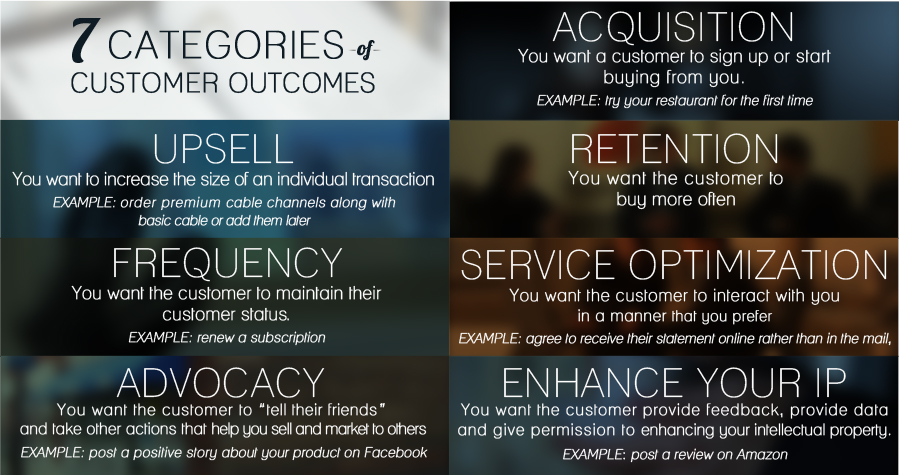
Driving Business Growth through Customer Behavior Modeling
What is the single most impactful factor you can change to make your business grow and increase your profitability? It probably involves influencing human behavior.
For example, if you could succeed in influencing:
- Your employees to be more motivated to serve customers
- Your customers to buy more frequently
- Your suppliers to extend more credit
- Your retailers to more aggressively sell your product
- Your shareholders to hold their stock
Your business would benefit. In fact, the vast majority of all business value is created by influencing human behavior.
Customer Behavior Modeling (CBM) is a methodology to support teams that are defining and prioritizing the characteristics of products or marketing programs so that the investment in creating those experiences is optimized, and the behavioral results are maximized.
The CBM process is comprised of three steps:
- Define the customer behaviors that create value for your business and their typical sequences.
- Identify the different types of customers you have and what motivates the desired behaviors of each type.
- Write customer stories for each customer type that show how a series of experiences move the customer through the chain of behaviors, which ultimately lead to the behavior(s) that create value for your business.
Step 1: Define the customer behaviors that create value for your business and their typical sequences
If you want to influence certain behaviors to generate value, you must first know which of your customer behaviors actually generate value. Take some time to think about your customers, their behavior and which specific behavior generates value. The diagram below has 7 behaviors that we've identified to help you in thinking through this step.

7 Categories of Customer Outcomes
As you think through value generating behaviors that you want to encourage, you may also find it helpful to consider some value destroying behaviors that you want to discourage as discouraging undesirable behavior can create value for your business.
After you know the behaviors that create value, you will want to identify the behavior sequence that leads to these behaviors. For example, before creating value by purchasing, a customer might first read a brochure you mailed them then call your call center for more information. It could also be the case that there is more than one value-creating behavior in a chain (i.e. Customers must first "purchase" and "use the product regularly" before they can "reorder"). See sample chain below.

Customer Behavior Chain
Step 2: Identify the different types of customers you have and what motivates the desired behaviors of each type.
If you were a travel agent trying to offer a great deal on a trip to New York City, it would be helpful to know that the customer you're selling to LOVES the arts but couldn't possibly care less about dining selection, right? Knowing that information would inform which aspects of the NYC trip you would emphasize and which you would gloss over thus increasing your chance of making the sale. If you want to influence someone's behavior, it's enormously helpful to know something about them.
How well do you know your customers? What are their goals? What are their fears? What unmet needs do they have in their life? Have they ever heard of you? What do they think of you? Why do they buy your products? Why do they not buy your products?
When looking to identify the different types of customers that you have, getting answers for these questions can seem like quite the daunting task because the answers can potentially be different for each individual. But customers are more alike than we think they are. I've heard it said that customers, like snowflakes, are all different; however, also like snowflakes, many are extremely similar… or at least share some common traits.
There are three parts to identifying the different types of customers that you have: Defining customer categories, defining customer dimensions and creating customer personas
Here's a helpful example to help us see what defining customer categories looks like. If you're Microsoft, your customers fall into three categories:

You can further breakdown those categories into subgroups like the following to get a better understanding of different segments:

Breaking your customers down into categories like this is fairly straightforward, but it isn't the end of the exercise. The second part of this process involves breaking them out by dimensions.
Your customers have a variety of characteristics that distinguish them from one another. For example, gender — you (most probably) have both male and female customers. Your customers have different ages. They may live in different geographic areas. They might speak different languages.
How many dimensions are there? The list is unlimited. However, most dimensions fall into one of these dimension types.
- DEMOGRAPHIC: age, gender, marital statur, etc.
- ECONOMIC: income, savings, debt, home ownership
- PSYCHOGRAPHIC: attitudes such as "green", political tendencies, mindset about money, health, etc.
- LOCATION: Where the person is located
- INTERACTION PREFERENCES: How they prefer to interact- web vs store vs phone, etc. Also preferred language of interaction.
- RELATIONSHIP STATUS: Are they already your customer? How often do they buy? Not yet a customer? Customer of a competitor? Former customer? Member of your loyalty program?
- BUYING STAGE/TIMING: Where is the customer in the lifecyle of a purchase decision (awareness, evaluation, consideration, contracting, post purchase, renewal consideration) or what is the urgency of their purchase.
- AFFINITIES: Hobbies, tastes in music, food, culture, sports teams, celebrities they have a special connection to, etc.
- MOTIVATION: What has put them into the market at this moment? Special occasion?
- BUSINESS SPECIFIC: Information that makes a difference in terms of how you might serve that person that would probably be irrelevant for a different type of business.
- Examples: Does your home have gas or oil heat? (energy company) Have you ever been on a cruise before? (travel agent) What is your golf handicap? (sporting goods store) Dietary Restrictions (food services), etc.

Once you have identified the different types of customers that are most relevant to your business by analyzing the different categories and dimensions, the next step is to create personas. For example, if you were a mobile phone company, one of your customer personas could sound like this:

Once you have created your personas, the next step is to determine which of your behavioral sequences from Step 1 apply to each of your personas. Then start to write stories for each of your personas that flesh out "real world" scenarios in which your customer moves through the lifecycle of awareness, consideration, purchase, and perhaps support, re-purchase and advocacy. The initial focus should be on creating your vision for the optimal story (or several optimal stories) for each persona.
These stories will ultimately help to give you a clearer understanding of your customers and they will facilitate the product development and product marketing processes.